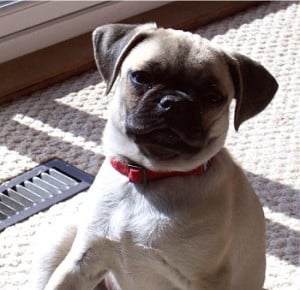Good day and welcome everyone!
This is Sharda with another Pugs newsletter.
Today we will discuss about Pug chewing problems!
Pugs usually throw in destruction as part of their playtime.
This may include digging, chewing, shredding and shaking toy-like objects.
Since pug dogs check out foreign objects by pawing them or eating them, they may harm themselves or damage items in the environment.
- Your Pugs, however, could also chew strange objects if:
You leave him alone for long periods without a chance of meeting you or other members of your family.
He has no playmates or toys.
He’s too small to do anything on his own and has no way of spending his energy.
He’s an active dog who needs to be stimulated with games and an outdoor life.
OVERCOMING DOG CHEWING
Ignore his behavior completely. If yours is a submissive pug dog, he will react in accordance to your presence. So, if you choose, you could ignore his outburst when you return home or her great love for you, and you will notice that he will stop displaying these behaviors.
Give him enough time so that you can play together in a safe space such as a yard. But if you don’t have a yard, try using a tennis court. Play fetch with him, as this is sure to burn up his excess energy.
Take him for walks. Treat walks as perfect opportunities for you and your dog to spend time together. On walks, give him enough time to smell, sniff, explore and praise him for everything he does.
Stimulate him mentally by teaching him a few commands and tricks and practice them every day. Alternatively, you can attend obedience classes.
Give him lots of toys to play with. Rotate his toys to keep his interest in them alive. Keep trying out a range of toys and watch he doesn’t tear to bits any new toy you give him.
Try giving him those toys that are filled with food. If you surprise him with such toys it will help him focus his chewing on these toys instead of biting other things.
Cover all the objects you don’t want him to chew with heavy plastic, aluminum foil, hot pepper sauce or a commercial “anti-chew” product.
Consider putting him on a good doggie day care program for two or three days a week to work off some of his unburned energy.
Crate train your pup so that he stays away from all dangerous things and those things he loves to chew such as electrical cords of appliances that are plugged in.
If you give in to his chewing habit by giving him discarded socks or shoes to chew, he will understand that all socks and shoes in the house are open to him to chew.
You could get a good long rope for recall training, or even a nylon buckle collar and a six-foot leash to start him off on a simple training regimen.
Start him off on an exercise called the “tree” method in which you become an immovable object until your dog ceases to recoil at the leash and stops reacting to it.
If you want him to chew a particular thing, then give to him accompanied with praise, petting and positive reinforcement, but if you want to negatively reinforce his chewing habits, take away what you don’t want him to chew and say.
“No, this is mine,” and give him his ball or bone to chew, with the words, “Good boy!”
When he’s cutting a tooth, give him frozen rubber teething rings to ease the pain, something that will last from age five months to over one year.
Stand at a particular spot and allow him to sniff the area. Let him wander off in a particular direction. You continue to stand immobile, letting him pull but not necessarily resisting his pull.
When you notice his resistance to pulling receding, let him lead you by the leash where he wants to go and as you go with him, praise him loudly, fervently and repeatedly. If he gets back to pulling on the leash, stand immobile yet again. Keep going on this way and become a tree as and when he begins to pull.
Alternatively, you could keep walking in different directions. If he walks ahead of you, walk in another direction very quickly. When he resists pulling the leash again, praise him once more.
Try using a good training collar as a training aid rather than a permanent control solution. From these above-mentioned ways of dealing with your Pug, you probably realize that this works best if your Pug is still so small that he doesn’t outweigh you.
I hope that you learned a lot from today’s Pugs newsletter
All the best and take care
Warmly,
Sharda Baker

